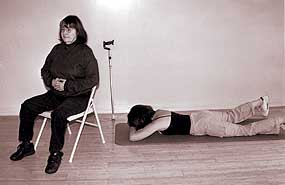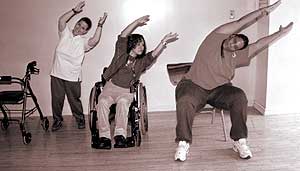Yoga
It is difficult to find balance without the ability to look inward, whether it is physical balance or balance in our daily lives. Starting the day healthfully can be as simple as breathing and stretching. An important component of a total fitness program is stretching. Add focused deep breathing to a stretch and you’ve entered into the world of yoga.
The dividends you receive from a consistent yoga practice may take you to standing and seated stretches may take you to places you may not have thought about, like cross-country skiing or on a journey of self-discovery. Yoga is not a religion. It has nothing to do with yogurt.
Yoga, a Sanskrit word that translates into “union” or “to yoke”, is the ancient path to well-being. It is a 5,000 year-old art and systematic science that is a powerful union of body, mind, and spirit. It is the secret to developing a state of stability, ease and inner peace.
Of all the types of yoga, Hatha yoga is the one most commonly taught and practiced in the United States. “Ha” means “the sun” and refers to the right side and “tha” means “the moon” and refers to the left side. To practice Hatha yoga does not necessarily mean to exclude the other paths.
Anyone from an athlete to a couch potato can practice yoga. It is non-competitive, and takes into consideration your physical condition, your age, your ability or disability. Yoga starts wherever you are.
Begin your practice with breath awareness. Learn to become an observer of the flow of breath throughout the body. With practice, this is how you will move into and out of your asanas (poses). Never strain in an asana. Do not hold your breath. Go only as far as you feel comfortable.
Floor Crocodile (Makarasana)
 Lie on your stomach, on the floor or the bed. (If this is not possible, see seated crocodile pose.) Fold your arms so that the hands are inside your elbows. Elevate your chest slightly, keeping the abdomen on the floor. Rest your forehead on your forearms. Relax the legs so they are comfortable, either together or apart.
Lie on your stomach, on the floor or the bed. (If this is not possible, see seated crocodile pose.) Fold your arms so that the hands are inside your elbows. Elevate your chest slightly, keeping the abdomen on the floor. Rest your forehead on your forearms. Relax the legs so they are comfortable, either together or apart.
Close your eyes and relax the body. Begin to bring your awareness to the breath. Observe your breath without judgment as it moves in and out of the body. Is it smooth or jerky? Is your breath shallow or deep? Is it cool? Is it warm?
While inhaling, feel your abdomen gently pressing against the floor or bed. While exhaling, feel the abdomen release back toward the spine. When resting on your stomach and breathing in this manner, the lower back and the sides of the rib cage also expand. Attempt to release any muscle tension in the back to allow the breath to deepen.
Remain in crocodile pose for 3-5 minutes. Observe the movement of the breath and the body. When you are ready, come out of the pose slowly and with awareness. Developing an awareness of your thoughts and listening to your body are an integral part of the yoga practice.
Seated Crocodile
Come to a comfortable seated position with your back away from the chair (or wheelchair). If you have difficulty with this, take a towel, fold it in half and then roll the towel lengthwise. Place the towel behind you to assist with keeping the back straight. Be sure the feet are resting on the floor. Place a pillow or phone book under the feet if they do not reach the floor.
If possible, place one hand on your lower abdomen tofacilitate the belly and diaphragm moving in the correct way. If you are not using your hands, imagine a weight on the front of the abdomen. Draw your attention to the breath, and close the eyes. As you inhale, allow the abdomen to move outward. At first you might want to exaggerate this movement. Exhale and press the abdominal muscles back toward the spine. When it feels easy to practice this technique, allow the abdomen to move out slightly on the inhale, then move the breath into the lower back. This will initiate the rib cage to also expand slightly as you engage the diaphragm muscle. Practice this for 3-5 minutes.
The next pose increases flexibility in the spine, the muscles around the spine, arms and rib cage. It gives the diaphragm a good opportunity for stretching as well. The pose can be done standing or seated.
Standing Side Stretch (Ardha Chandrasana I)
 Stand with your feet together, hip distance apart, or slightly wider, whichever position feels right for your body. If all positions feel fine, experiment with each position of the feet and notice the difference in the stretch and the breathing. Allow your arms to rest at your sides.
Stand with your feet together, hip distance apart, or slightly wider, whichever position feels right for your body. If all positions feel fine, experiment with each position of the feet and notice the difference in the stretch and the breathing. Allow your arms to rest at your sides.
Inhale, raise the right arm to shoulder level, turn the palm of the hand up and continue lifting the arm until it is overhead. As the arm is lifting, draw the right shoulder blade down into the back. Exhale, lengthening the right side through the side ribs to the fingertips. Inhale and lift the chest (sternum) upward slightly. Spread the fingers, exhale and lean to the left. Do not tilt forward or backward. Allow the left arm to slide down the left leg. You may use the left arm for support, so long as you do not collapse into the left side.
You can also do this pose with your fingers interlaced overhead and the index fingers straight up. Remain there for three to five breaths. Continue to breath deeply into the stretch and observe the breath and the sensations of the body. When you are ready to come out of the pose, inhale and lift the arm back overhead. Exhale and release the arm to shoulder level. Turn the palm downward and continue to release the arm. Repeat on the other side. Do the asana two times on each side.
Seated Side Stretch (Ardha Chandrasana I)
Find a comfortable seated and erect position. Use a folded blanket behind your back if you need additional support. Continue with the Standing Side Stretch instructions. The arm that is sliding down the leg can reach towards the floor or hold onto the bottom of the chair or chair leg or you can choose the asana with the fingers interlaced.
As with any pursuit, regular practice and effort usually result in positive benefits. According to B.K.S. Iyengar, an internationally recognized authority on Hatha yoga, “Regular practice of yoga can help you face the turmoil of life with steadiness and stability.”


